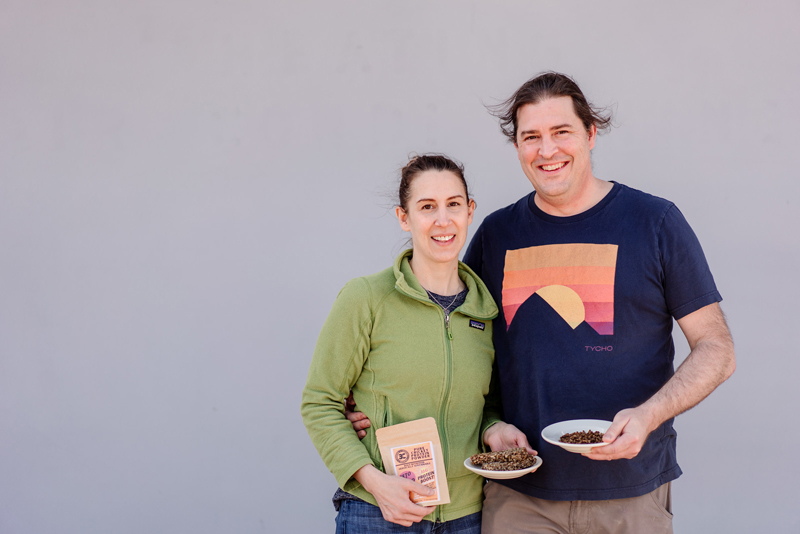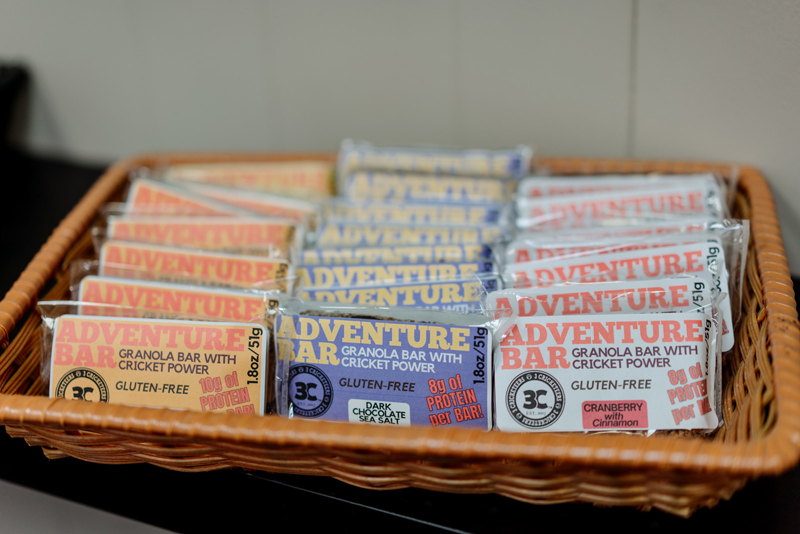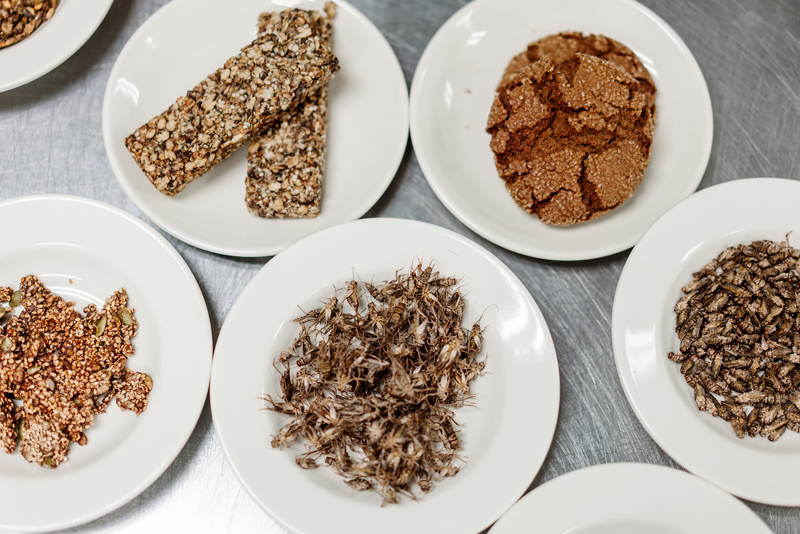PHOTOS BY BECCA DILLEY
There’s a cricket farm in St. Louis Park.
We’ll let you wrap your mind around that for a moment.
If your first response is a combo of how/why, Claire and Chad Simons, the married 3 Cricketeers founders and farmers, gave us answers. The idea was a melding of each of their personal passions: Chad studied environmental law and is focused on sustainability. “We’d have these conversations, he’d say, ‘There’s not going to be enough water. There are too many people on the planet.’ And I’d say, ‘Can I just watch this Netflix show?’” Claire said, laughing. “I don’t take all this on. But he wanted to do more and asked me to start a little cricket habitat in our basement.” Crickets, which are widely eaten in other countries (including Thailand, Mexico, and several African countries), are also an environmentally friendly form of protein, requiring little feed or water. Their three sons were enthusiastic about the venture, hence the company’s name.
Claire is a nurse, and her passion for health and wellness, and the role food plays in those, sent her on a research adventure to discover the nutritional value of crickets. “I could not believe the protein, the B12, the iron, calcium, and the big one, the prebiotic fiber,” she said. “I began sneaking it into all of our foods, and the boys loved it.” Crickets can add a crunch or saltiness to some foods, but when powdered, can add a lightly nutty taste to foods.
 The couple decided to move the crickets out of the basement and create a farm, starting in a 750-square-foot storage unit. They quickly outgrew that and moved into their current location, a 3,500-square-foot warehouse.
The couple decided to move the crickets out of the basement and create a farm, starting in a 750-square-foot storage unit. They quickly outgrew that and moved into their current location, a 3,500-square-foot warehouse.
But growing a cricket farm wasn’t without its challenges, not least of which was how to educate people. “When we first started out, we thought people would buy frozen raw crickets next to the frozen raw shrimp,” Claire said. “But people didn’t know what to do with it. Maybe down the road, that’ll work.” When Andrew Zimmern announced he was opening Lucky Cricket in St. Louis Park, the couple thought that was a solid lead. “We thought we can get it in there, but even they just wanted to use it as a garnish,” Claire said. “We began to realize that cricket powder was really the gateway into allowing people to try this and not be grossed out. So we started dehydrating, blanching, dehydrating, and now we feel like we’ve gotten our process down where we’re really retaining all the nutrients and texture and flavor, and milling and sifting them into a nice fine powder.”
It can take upwards of 4,000 crickets to make a pound of powder, which is sold for $50 a pound. At 3 Cricketeers, the crickets are farmed vertically, allowing for optimal air flow and temperature control. The Simons’ note that the crickets live in large cricket “condos” made from chipboard and egg flats. As for feed, organic, non-GMO vegetarian chicken feed is the main source, supplemented with organic fruits and vegetables.
The larger space gave them the opportunity to do more than farm crickets and make protein powder. “We built a commercial kitchen in one corner,” Chad said. “It’s all approved, licensed.” The idea was to make food products that could act as an alternative gateway, such as protein bars and chocolate-covered crickets.
POWERFUL POWDER
Then Nixta’s Gustavo Romero became involved. The Simons had been asked to demonstrate cricket cooking at the 2019 Minnesota State Fair, and they in turn invited Romero. “Our idea was we wanted to demystify crickets, show how you can put the powder in anything,” said Claire. “I had my little Vitamix and my little food processor. Then Gustavo shows up and has a five-course meal going. We had a line wrapped all the way around the booth.” Romero made a tomato bisque soup that involved boiling the crickets in the soup, and people’s response was that it was the best tomato soup they’d ever had. (Romero is currently developing a cricket tortilla at Nixta.)
 The Simons have seen steadily increasing demand for their products and powder, sold on their website and at local retailers including MinnyRow Market and Linden Hills Coop. “There’s only a handful of us farms right now,” Claire said. “But another exciting thing is the studies that are being done. Our crickets were used in a Purdue University study. Studies are finding that crickets may have anti-diabetic, anti-inflammatory, and anti-hypertensive properties.”
The Simons have seen steadily increasing demand for their products and powder, sold on their website and at local retailers including MinnyRow Market and Linden Hills Coop. “There’s only a handful of us farms right now,” Claire said. “But another exciting thing is the studies that are being done. Our crickets were used in a Purdue University study. Studies are finding that crickets may have anti-diabetic, anti-inflammatory, and anti-hypertensive properties.”
Early adopters are endurance athletes. “They’re looking for that alternative protein that’s not going to tear up their stomach,” Chad said. “And many of them have that sustainability passion as well. They’re outdoor enthusiasts. They really care about what they’re eating, where it comes from. Eating low on the food chain. Maybe they’re starting to eat more plant-based, but they’re not all the way there.”
The evolution from frozen raw crickets to cricket protein powder required some shift in thought, and a shift in the business model. “Powder is a more expensive product,” Chad said. “But when we can mix it with other ingredients, you’re able to get that margin down. There’s value added with the processing, and we get pretty hefty margins.” He noted that one of the challenges in the cricket farming industry is to bring the cost of the crickets low enough so that the cricket is an ingredient that other manufacturers can use to produce products themselves.
 There are also tradeoffs in terms of being an urban farmer. “We’re in a warehouse, so the rent’s going to be a little bit higher. But we’re very happy with our landlords, they’ve worked with us very well. Farmers in other rural areas benefit from lower rents. However, we’re able to access our markets easily. We have our commercial kitchen there. We have a loading dock. With our business model, being more of a kind of a retail-ready product at the end, it’s different than just farming crickets on your own.”
There are also tradeoffs in terms of being an urban farmer. “We’re in a warehouse, so the rent’s going to be a little bit higher. But we’re very happy with our landlords, they’ve worked with us very well. Farmers in other rural areas benefit from lower rents. However, we’re able to access our markets easily. We have our commercial kitchen there. We have a loading dock. With our business model, being more of a kind of a retail-ready product at the end, it’s different than just farming crickets on your own.”
Crickets require little in the line of feed or water and are essentially vertical farming, taking up little space, making them easier to farm than chickens. But chickens have an awareness edge. “With the chicken industry, these are products that are already familiar to the consumer,” Chad said. “So we have a little bit of a marketing challenge. Our marketing numbers might be higher than a chicken farm. But our model is both the farm and the commercial kitchen, which is unusual.”
In the meantime, the Simons are hoping—as are so many—that the Minnesota State Fair will return this year. They’ve been invited back for more demonstrations and plan to add a cooking contest with their powder. “We’re really excited about that,” said Claire. “Just to get people excited, just to see what people come up with. We hope the State Fair’s happening. We’d love it.”

